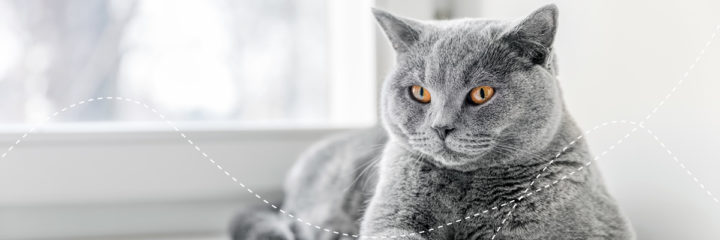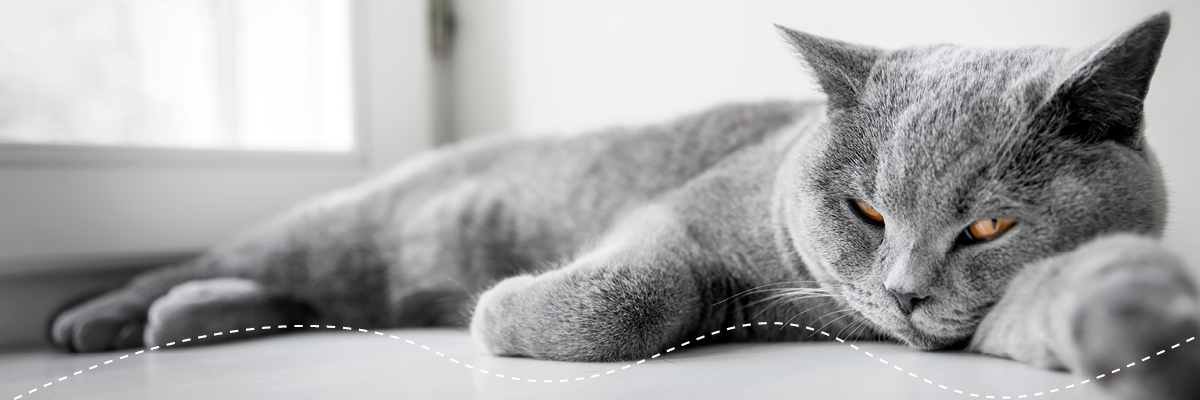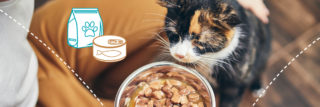
*Advertisement – brand name mentioned
A recent case report on cat Lilly shows that a urethral stone can acutely exacerbate CKD in cats with chronic kidney disease. With urethral stones blocking the draining urethra, urine backs up into the renal pelvis, causing it to dilate.
If the urine cannot pass, the toxins remain in the blood. This leads to an increase in uraemic toxinsToxic, nitrogen-containing urinary substances responsible for uraemia and kidney damage.... (= kidney toxins) and also to an increase in kidney parameters such as creatinineCreatinine is a breakdown product of muscle metabolism. Its blood level is dependent, among many factors, on age, weight, nutritional status and muscle mass. Hence, creatinine levels in the blood vary from individual to individual. Creatinine is continuously excreted in the urine. Increased blood creatinine..., ureaUrea is the nitrogen-containing breakdown product of protein metabolism. The nitrogen from the proteins is converted to ammonia in the liver, which is combined with carbon dioxide to form urea. This is continuously excreted via the kidneys but also via sweat. Urea is one of... and phosphate. In addition, there is a pressure load on the filtration units (nephronsNephrone sind die Filtereinheiten der Nieren....) and thus an additional dysfunction of the affected kidneys. This is particularly tragic in the case of existing kidney damage in CKD, as it promotes the progression of CKD. This worsens the condition of the cat with kidney disease. Even if the cause is not in the kidney itself but in the urinary tract.
Such urethral stones are usually inconspicuous and clinically “unremarkable”. Only when they cause problems do they have to be removed, which is not easy in the cat. Most (about 90 %) of these stones are made of calcium oxalate and therefore cannot be dissolved. In Lilly’s case study, a surgical approach was taken. Kidney values improved after surgery, but rose again after 1.5 years. The main problem in the CKD cat was loss of appetite and subsequently weight loss.
No appetite with CKD
Cats with chronic kidney disease lose their appetite. They are not only less active, but also eat without pleasure. The cat’s fatigue and general weakness are usually a result of emaciation due to insufficient food intake in the absence of appetite. There is a good chance that the listlessness is related to elevated blood levels of uraemic toxins. Uraemic toxins such as indoxyl sulphate accumulate first in the blood and then in the various organs where they can exert their harmful effects. (See blog post Uraemic toxins).
If there is a loss of appetite, fewer proteins are also absorbed, from which fewer uraemic toxins can then be formed. This has only an illusory advantage, because there are still high amounts of these kidney toxins in the organs and in the blood, as the diseased kidneys can no longer excrete them sufficiently. However, the reduced protein intake has negative consequences for the CKD-afflicted cat.

Protein deficiency due to lack of food or/and kidney diets
A protein deficiency can have fatal consequences for obligate carnivores. On the one hand, it is desirable for the cat to eat less protein so that fewer uraemic toxins can be produced. On the other hand, a protein deficiency is associated with a loss of muscle mass, as the cat digests its own muscle.
The cat’s metabolism is highly specialised in digesting large amounts of protein. If the cat finds too little protein in its food, it begins to use its own protein reserves, which are found in the muscles. The breakdown of the body’s own muscles in turn leads to further weakening of the cat and also to an increase in creatinine. Creatinine is produced during muscle metabolism. Furthermore, a protein deficiency in the cat makes itself noticeable through an increased susceptibility to infections, depression and a disorder of the nervous system, blood formation (e.g. visible in the form of anaemia) and also as a wound healing disorder.
Kidney diets contain less protein to avoid the problem of uraemic toxins. However, the most relevant renal toxin, indoxyl sulphate, is formed from an essential amino acid. Therefore, this amino acid must also be included in renal diets. Meanwhile, the question of protein reduction in CKD cats is controversial among experts. Especially since kidney diets often do not contain highly digestible proteins, but wheat gluten, a vegetable protein that is not a natural protein base for carnivores.
The quality of the proteins is crucial, not the quantity?
Highly digestible proteins are proteins that are already broken down in the small intestine. They therefore do not even reach the large intestine, where the natural intestinal flora breaks down proteins. During this microbial digestion in the large intestine, the preliminary stages of uraemic toxins are formed. So this is where the mischief begins. With highly digestible proteins, the formation of uraemic toxins could be naturally reduced without having to reduce the total amount of protein in the feed. This is at least one conceivable approach to counteracting the rising blood levels of uraemic toxins. While maintaining palatable proteins for the cat.
However, such highly digestible proteins are very expensive because they are contained in pure muscle meat and offal, for example. This may possibly be a reason why only a few feedstuffs contain highly digestible proteins at all, and then only in small (?) quantities.
Meanwhile, there is a relatively new approach to oral dialysis to significantly reduce uraemic toxins. For this, a highly specific adsorber (binder) is mixed over the food, which only traps the uraemic precursors from the intestine and then excretes them with the faeces. This leads to a reduction in the blood level of kidney toxins and is a harmless approach for the cat. This happens regardless of the amount and type of protein ingested, i.e. with any food.
Cats are protein gourmets
Cats love proteins. They can smell it well and it tastes good to them. This is exactly the problem with kidney diets. Many cats don’t like them or refuse them in the course of CKD. In cats with a lack of appetite, this is problematic if the cat does not eat its entire portion. Desired protein reduction through renal diets can lead to further unplanned protein deficiency in the cat if it does not eat its reduced protein diet food or does not eat all of it. The cat may then become undesirably protein deficient with the above consequences.
Winning with weight
Studies have shown that cats with good or even overweight nutritional status have a better chance of survival in CKD. Therefore, in individual cases, it may make more sense to keep the beloved food than to switch to kidney diets that are poorly eaten by the cat. The main point is to keep the cat eating and therefor at a good weight. In the long run, too. For the uraemic toxins and also for the phosphate excess that can arise in connection with feeding meat and offal to the chronic kidney diseased cat, appropriate supplementary products that reduce the blood level are available from the vet.
Consistent eating is essential in CKD
In addition to offering good tasting (high quality protein) food, a stimulant can be given, at least temporarily, to help stimulate the appetite. There are different possibilities available here. The administration of medicines and drugs is very difficult, especially with poorly eating cats. So that orally administered tablets can usually not be given. A new ear ointment, in which the active substance (mirtazapine) reaches the bloodstream directly through the fine skin of the ears, can be applied easily and regularly by the cat owner. Usually, a reduction of uraemic toxins through the oral adsorber is also associated with an increase in appetite. In Lilly’s case, the ear ointment has initiated a positive turnaround and helped stabilise her weight.
Bibliography:
- Dahlem, D. (2021): Akuter Schub der chronischen Nierenerkrankung bei der Katze – erkennen und therapieren. Katzenmedizin, 3, S. 16–20.
- Fröhlich, L. (2021): Lilly – Akute Dekompensation einer chronischen Nierenerkrankung – Fallbericht. Kleintiermedizin, 4-21, S. 24–27.


